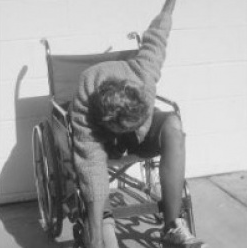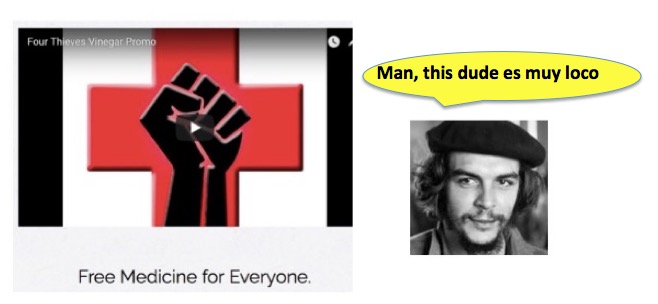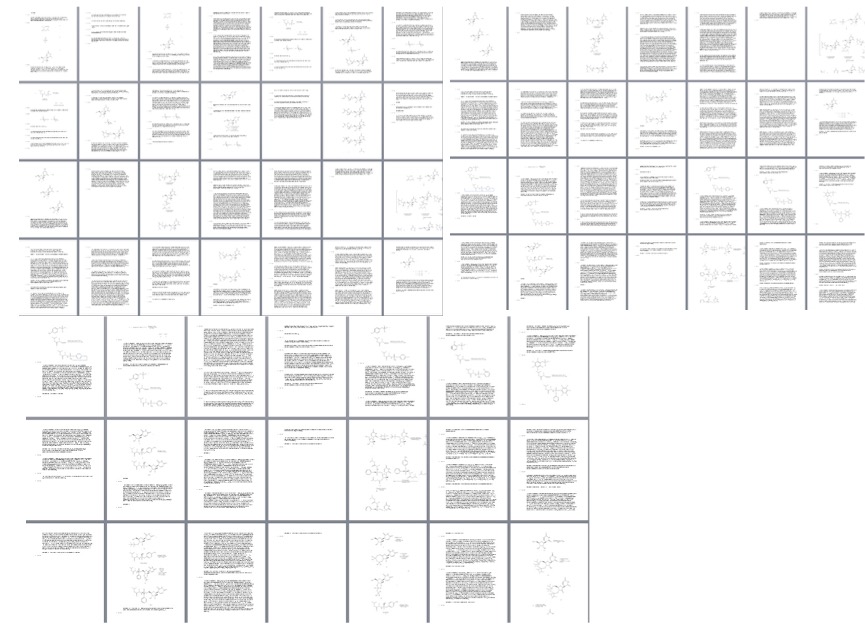
In the unlikely event that your "people who are talking out of their ass" list is growing too short, fear not. Help is on the way. All you need is to read STAT's Charles Piller's insane article about Michael Laufer, a self-proclaimed hero of the masses, who wants to teach you how to synthesize your own prescription drugs to save yourself a ton of money, while at the same time, keeping it from those evil drug companies. How precious! And what could possibly go wrong? Maybe this?

A Frozen Addict from 1982. Source: Neurology Update.
This guy was not doing Pilates. Well maybe so if you count it as "Permanent Pilates." Nope, he is one of a cluster of victims who, on 1982, tried the wrong batch of a street drug called desmethylprodine (aka MPPP, China White) - a simple mistake made by a simpleton in a simple garage in California. Shortly thereafter bad things started to happen. A cluster of six drug users who had taken MPPP came down with Parkinson-like symptoms (See: Frozen Addicts, Garage Drugs And Funky Brain Chemistry). How did this happen (1)? Because a chemist screwed up one very simple reaction while performing synthetic organic chemistry. How surprising! I mean, can't any dope mix a few chemicals together in the kitchen and stick it to big pharma? Or perhaps there is more to it. Otherwise, why would we organic chemists spend 5-7 years learning how to do it properly?
Enter Laufer, who thinks he can teach people to "cook" their own drugs at home. Laufer is the brains behind "Chem Guevara"-like group called Four Thieves Vinegar. Here is their logo:

OK, maybe I doctored that up a bit, but that doesn't necessarily make it inaccurate:
"The anarchist grew animated as he explained his plan to subvert a pillar of global capitalism by teaching the poor to make their own medicines — pharmaceutical industry patents be damned."
Charles Piller, STAT. October 12, 2017
Does Four Thieves Vinegar seriously believe that it can teach an accountant who is infected with hepatitis C to make Sovaldi, one of the drugs mentioned, with a waffle iron in his kitchen and save $80,000? Or maybe they are punking us? Nope- these screwballs appear to be serious. From their website [emphasis mine]:
"Medicines like Solvadi which costs $80,000 for a course of treatment, is beyond the reach of most people... The design will be published online, along with synthesis programs. The system will also have a forum system for users to communicate and contribute to the development of the system. With time, the system will become self-sustaining, much like other open source movements."

Photo: Gale's Mind
So, by all means, let's take a look at what it really takes to make yourself some Sovaldi. Gilead has very little to worry about. But if you try to follow this lunatic's advice you have plenty to worry about. Ready to make some Sovaldi? Sure, let's go. But you might want to make sure that your life insurance premiums are paid up.
Just to give you an idea of what you'll be dealing with, let's just start with the chemical name for Sovaldi:
Isopropyl (2S)-2-[[[(2R,3R,4R,5R)-5-(2,4-dioxopyrimidin-1-yl)-4-fluoro-3-hydroxy-4-methyl-tetrahydrofuran-2-yl]methoxy-phenoxy-phosphoryl]amino]propanoate
Doesn't sound too bad, right? I mean, it's just one drug. So maybe the name is a little funky, but the name, no matter how scary it looks doesn't mean that it's hard to make the stuff. But this may:

Some of the 62 pages in Gilead's Sovaldi patent which supposedly allow you to make it. At home. My sides!
The Faustian nightmare above is even worse than you might think. You are looking (only) at the portion of US patent US20100298257 A1, which was issued to Gilead in 2010. Patents must disclose how to synthesize the compound(s) that are covered in the patent, but the "Rorschach test" above is only a small portion of the entire patent, which is 153 pages long and contains more than 35,000 words. The "preparation" section consists of a mere 13,000 words on 62 pages that disclose how Gilead made the stuff.
OK, don't get discouraged. Just because it's long doesn't mean it's all that difficult, right? After all, who amongst us couldn't pull this off? Or not. Below I have listed four random sentences from four random pages in the patent's experimental detail section (the instruction manual). This part of the patent tells you how to make and use the dozens of chemicals that it takes to make Sovaldi. Good luck.
- In a 10 L flask, was added 3′, 5′-O-dibenozyl-2′-deoxy-2′-fluoro-2′-C-methyl-N4-benzoylcytidine (500 g, 0.874 mol) and 70% aqueous acetic acid (7.5 L). The solution was heated to reflux (110° C.) for 20 h. TLC indicated a complete reaction (Rf 0.6 in 5% methanol in dichloromethane (DCM)).
- Most of the the major impurities (di-(isopropylalanyl)phenyl phosphate, 3′,5′-bis phosphoramidate (6), 3′-phosphoramidate-5′-TBDMS adduct (7)) eluted with ˜3% gradient.
- Characterization of the mixture of isomers (4): 1H-NMR (CDCl3) δ 10.05 (br s, 1H, NH, SP), 10.00 (br s, 1H, NH, RP), 7.49 (d, 1H, C6-H, SP), 7.36 (m, 5H, C6-H, RP, aromatic), 7.23-7.14 (m, 6H, RP/SP, aromatic), 6.18 (br d, 2H, C1′-H, RP/SP), 5.63 (d, 1H, C5-H, SP), 5.58 (d, 1H, C5-H, RP), 5.01 (m, 2H, CH—(CH3)2, RP/SP), 4.46-4.33 (m, 8H, C-5′-H2, ala-NH, C3′-OH, RP/SP), 4.12 (m, 2H, ala-CH—CH3, RP/SP), 4.01-3.85 (m, 4H, C3′-H, C4′-H, RP/SP), 1.39-1.22 (m, 12H, all CH3, RP/SP).
- The white solid was filtered and washed with IPE (5 mL) to give 1.28 g of product. 31P NMR revealed that the above product contains 77:23 mixture of P-4:R P-4 respectively. This was recrystallized from 20 mL of DCM to obtain 0.75 g of >99% pure SP-4 (about 12% from the uridine nucleoside).
So, this doesn't sound THAT bad, right. What's the harm in trying? Well, there are plenty of reasons, really:
Just for yuks, let's take a look the properties of a few of the hundreds of chemical reagents that I plucked out of the experimental section. There are all needed to complete this synthesis (2). Every one of these chemicals is found in the patent. Hazard information is taken from material data safety sheets.
- 4-Nitrophenyl phosphorodichloridate: Causes severe skin burns and eye damage
- t-Butylmagnesium chloride: Reacts violently with water. Catches fire spontaneously if exposed to air
- MTBE: Suspected carcinogen
- Sodium bis(trimethylsilyl)amide: Highly flammable liquid and vapor. Causes severe skin burns and eye damage Suspected of causing cancer.
- Trifluoroacetic anhydride: Reacts violently with water. Causes severe skin burns and eye damage. (Truly hideous to work with.)
- DAST: Flammable. Reacts violently with water. Harmful by inhalation, in contact with skin and if swallowed. Causes burns
- Sodium hydride: Blows up when exposed to water. Bursts into flame when exposed to air.
OK, you get it. These are just a few of the many chemicals that were used to synthesize Sovaldi. Try to keep a straight face and tell me that anyone out there can pull this off. With 27 years of organic synthesis under my belt, this is still a tough challenge. But, I'm a firm believer in one's right to do stupid things. If you want to give it a shot, may the farce be with you.
Because if you have hepatitis C and take "The Anarchist's" advice, one of three things is going to happen to you:
- The chemicals will kill you
- The hepatitis C will kill you
- You will die of old age long before you finish
Note the absence of any satisfactory outcome. There ain't one. Make your own drugs? One of the dumbest ideas I've ever heard. And considering that I deal with an astonishing assortment of morons pretty much every day doing this job, this is no small accomplishment.
Notes:
(1) The story really began in 1976 when Barry Kidston, a chemist in grad school, failed to control the temperature of a chemical reaction that was supposed to make a Demerol-like narcotic called desmethylprodine. At the higher temperature, a byproduct called MPTP formed, which headed straight for and then destroyed the substantia nigra portion of the brain, where dopamine is made. Result - instant Parkinson's disease. Kidston was unable to speak or walk. This "episode" is called "The Case of the Frozen Addict."
(2) During my career in drug discovery, I used every one of these chemicals multiple times. I enjoyed using none of them. But there is stuff out there that is far worse. See chemistry blogger superstar Derek Lowe's hilarious and brilliant look at "Things I Won't Work With."



